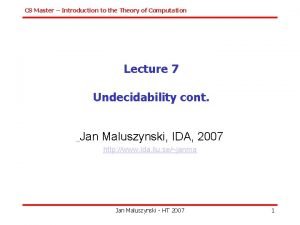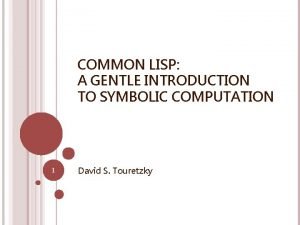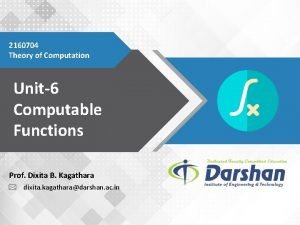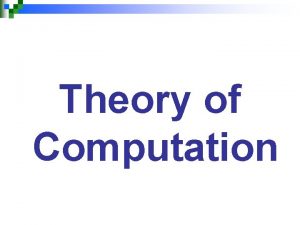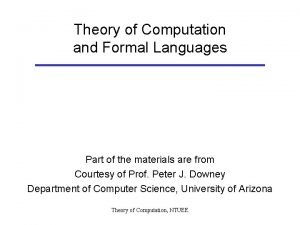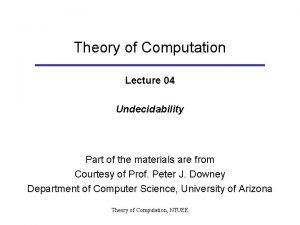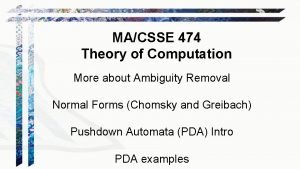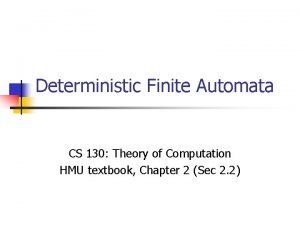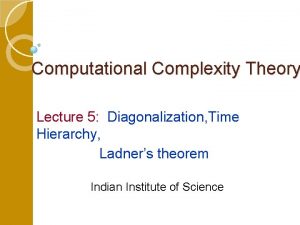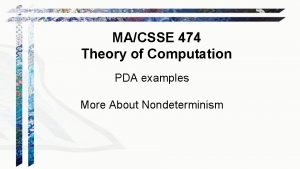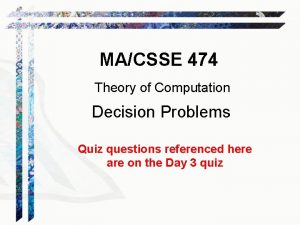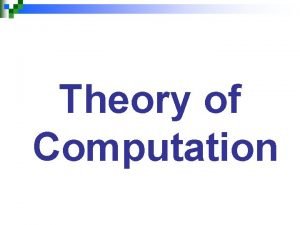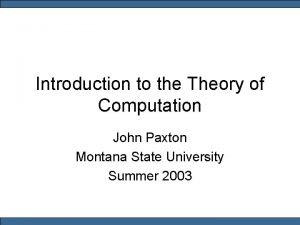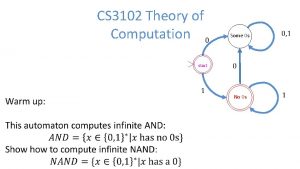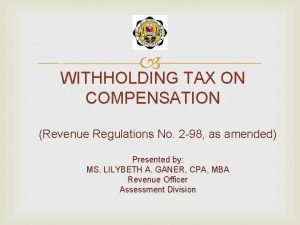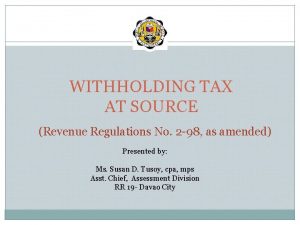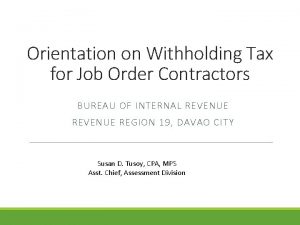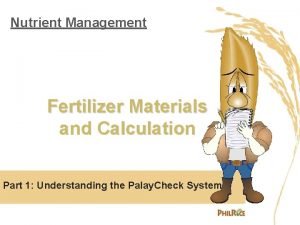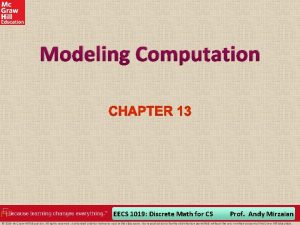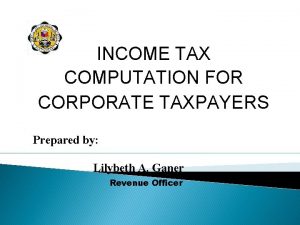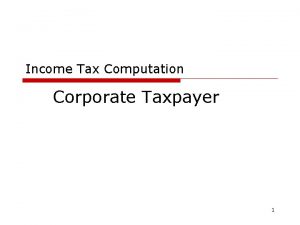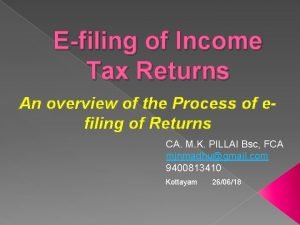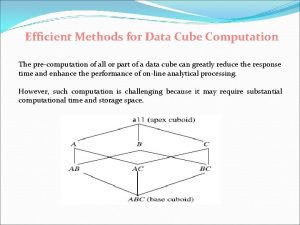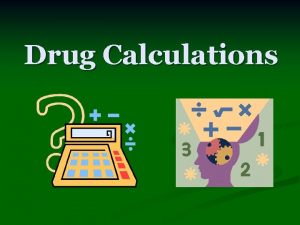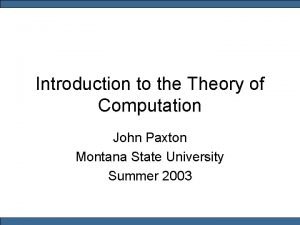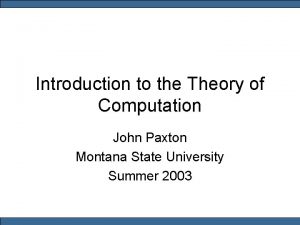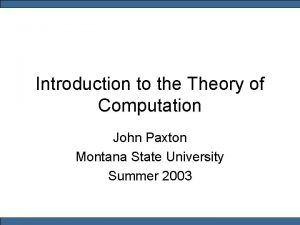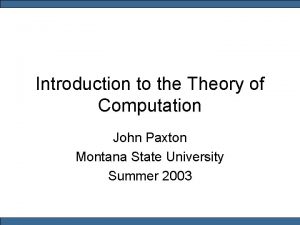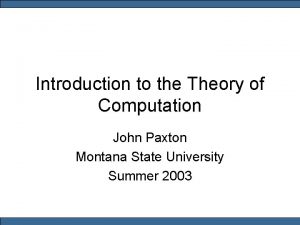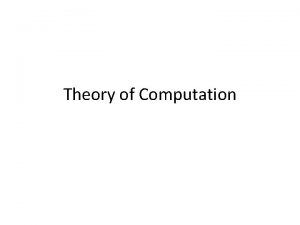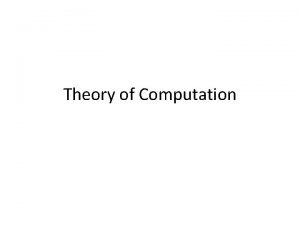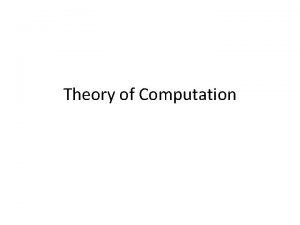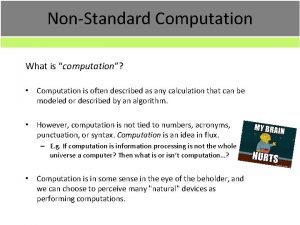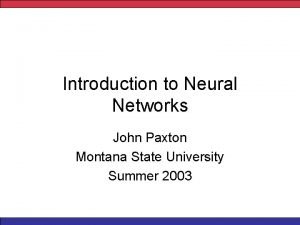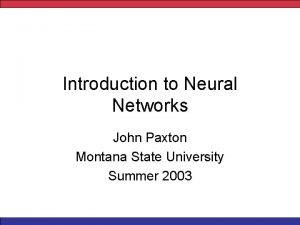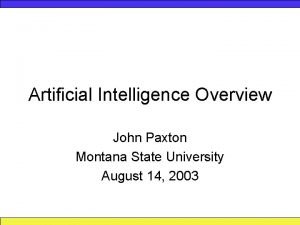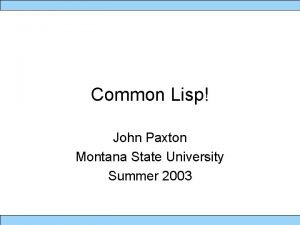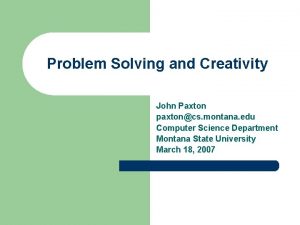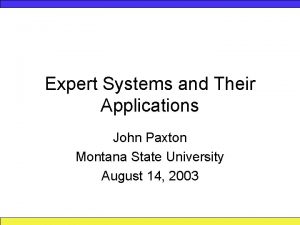Introduction to the Theory of Computation John Paxton






























- Slides: 30

Introduction to the Theory of Computation John Paxton Montana State University Summer 2003

Humor • A busload of politicians were driving down a country road when, all of a sudden, the bus ran off the road and crashed into a tree in an old farmer's field. The old farmer, after seeing what had happened, went over to investigate. He then proceeded to dig a hole to bury the politicians. A few days later the local sheriff came out, saw the crashed bus, and asked the old farmer where all the politicians had gone. The old farmer said he had buried them. The sheriff asked the old farmer, "Were they all dead? " The old farmer replied, "Well, some of them said they weren't, but you know how them politicians lie. "

1. 2 Nondeterminism • In a nondeterministic machine, several choices might exist at a given point instead of only one.

Example 2 0 q 2 0, e q 1 1

Example 3 • Write an NDFA that recognizes the language consisting of all strings over {0, 1} containing a 1 in the third position from the end.

Example 3 1 q 0 0, 1 q 2 q 3

Exercises • Give a 3 state NFA that accepts the language: zero or more 0 s, followed by zero or more ones, followed by zero or more 0 s followed by a 0. • Give a 1 state NFA that accepts the language {e}.

Formal Definition A nondeterministic finite automaton is a 5 tuple (Q, S, d, q 0, F) where 1. Q is a finite set called the states 2. S is a finite set called the alphabet 3. d : Q x Se P(Q) is the transition function 4. q 0 Î Q is the start state 5. F Í Q is the set of accept states

P(Q) • The power set of states • Consider Q = { q 0, q 1, q 2 } • Then P(Q) = { {}, {q 0}, {q 1}, {q 2}, {q 0, q 1}, {q 0, q 2}, {q 1, q 2}, {q 0, q 1, q 2} }

Example 3 • • Q = {q 0, q 1, q 2, q 3} S = {0, 1} q 0 F = {q 3}

Example 3, d 0 1 e q 0 {q 0} {q 0, q 1} {} q 1 {q 2} {} q 2 {q 3} {} q 3 {q 3} {}

Acceptance Let N = (Q, S, d, q 0, F) be an NFA and w = w 1 w 2 …wn be a string over the alphabet S. Then N “accepts” w if a sequence of states r 0 r 1…rn exists in Q with the following three conditions: 1. r 0 = q 0 2. ri+1 Î d(ri, wi+1) for 0 <= i <= n – 1 3. rn Î F

Theorem • Every nondeterministic finite automaton has an equivalent deterministic finite automaton.

Proof • Part 1 • Given a deterministic finite automaton, there is an equivalent nondeterministic finite automaton. • Proof. Trivial!

Proof • Part II. • Given a nondeterministic finite automaton, there is an equivalent deterministic finite automaton. • Proof. A bit harder …

Proof by Construction • Let N = (Q, S, d, q 0, F) • Construct M = (Q’, S, d’, q 0’, F’) • Q’ = P(Q) • q 0’ = E [ {q 0} ]

Proof by Construction • F’ = {R Î Q’ | R contains an accept state in N} • For R Î Q’ and a Î S, let d’(R, a) = {q Î Q | q Î E[d(r, a)] for some r Î R}

Convert Example 2 {q 1, q 2} 0 1 {q 0, q 1} 1 {q 2}

Exercise • Convert the following NFA into an equivalent DFA. e q 0 q 1 a a a, b q 2 b

Theorems • The class of regular languages is closed under the union operation. • The class of regular languages is closed under the concatenation operation. • The class of regular languages is closed under the star operation.

Closure Under Union • Note: we already proved this once using DFAs. • However, using NFAs, the proof is even easier so we will do it again!

Closure Under Union • Let N 1 = (Q 1, S, d 1, q 1, F 1) • Let N 2 = (Q 2, S, d 2, q 2, F 2) • Construct N = (Q, S, d, q 0, F) • Q = q 0 U Q 1 U Q 2

Closure Under Union • F = F 1 U F 2 • d(q, a) = d 1(q, a) if q Î Q 1 d 2(q, a) if q Î Q 2 {q 1, q 2} if q = q 0 and a = e {} if q = q 0 and a <> e

Exercises • Draw a picture that graphically displays how the preceding proof works. • Draw an NFA that accepts the union of {w | w begins with a 1 and ends with a 0} and {w | w contains at least three 1 s}

Closure Under Concatenation • Let N 1 = (Q 1, S, d 1, q 1, F 1) • Let N 2 = (Q 2, S, d 2, q 2, F 2) • Construct N = (Q, S, d, q 0, F) • Q = Q 1 U Q 2

Closure Under Concatenation • q 0 = q 1 • F = F 2 • d(q, a) = d 1(q, a) if q Î Q 1 and !(q Î F 1) d 1(q, a) if q Î F 1 and a <> e d 1(q, a) U {q 2} if q Î F 1 and a = e d 2(q, a) if q Î Q 2

Exercises • Draw a picture that graphically displays how the preceding proof works. • Draw an NFA that accepts the concatenation of {w | w begins with a 1 and ends with a 0} and {w | w contains at least three 1 s}

Closure Under Star • Let N 1 = (Q 1, S, d 1, q 1, F 1) • Construct N = (Q, S, d, q 0, F) • Q = {q 0} U Q 1 • F = {q 0} U F 1

Closure Under Star d(q, a) = d 1(q, a) if q Î Q 1 and !(q Î F 1) d 1(q, a) if q Î F 1 and a <> e d 1(q, a) U {q 1} if q Î F 1 and a = e {q 1} if q = q 0 and a = e {} if q = q 0 and a <> e

Exercises • Draw a picture that graphically displays how the preceding proof works. • Draw an NFA that accepts the star of {w | w begins with a 1 and ends with a 0}.
 Avery paxton
Avery paxton Autumn vinciquerra
Autumn vinciquerra Donna paxton
Donna paxton Union set operation
Union set operation Cosc 3340
Cosc 3340 Common lisp: a gentle introduction to symbolic computation
Common lisp: a gentle introduction to symbolic computation Theory of computation
Theory of computation What is transition graph
What is transition graph Theory of machines
Theory of machines Theory of computation
Theory of computation Ambiguity
Ambiguity Automata calculator
Automata calculator Diagonalization method in theory of computation
Diagonalization method in theory of computation Pda theory of computation
Pda theory of computation Theory of computation quiz
Theory of computation quiz Theory of computation
Theory of computation Dfa to nfa
Dfa to nfa The theory of computation
The theory of computation Cs 3102
Cs 3102 Tax due formula
Tax due formula Expanded withholding tax computation
Expanded withholding tax computation Expanded withholding tax computation
Expanded withholding tax computation Expanded withholding tax computation
Expanded withholding tax computation Fertilizer computation examples
Fertilizer computation examples Eecs 1019
Eecs 1019 Iaet sample computation
Iaet sample computation Income tax computation format
Income tax computation format Colloids iv fluids examples
Colloids iv fluids examples Income tax computation format
Income tax computation format Data cube computation
Data cube computation Drug calculation formula
Drug calculation formula




